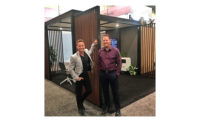 | |
It’s a considerable challenge to make a large, windowless, one-story floor plate of a neighborhood health clinic into a tectonic play of solids and voids, somehow drawing daylight into the interiors from 14 small terraces, and, all the while, staying within a tight budget and adhering to the exacting standards of a public project. The clinic, in the working-class Madrid neighborhood of San Blas, was designed by the three principals who make up estudio.entresitio—brother and sister, María and José María Hurtado de Mendoza Wahrolen and César Jiménez de Tejada Benavides.
Conceived as a prototype, the softly textured exterior of board-formed concrete is enlivened by an irregular profile, created by the towers enclosing rooftop mechanical equipment. With interior planes of cobalt-blue tile, the towers function as reflectors beside the terraces, forming a connection with the exterior along the vertical rather than the horizontal axis.

The three architects founded entresitio in 2000, after graduating from Madrid’s School of Architecture, where both María and César now teach. For the more complex program of a medical diagnostic and treatment center in Daimiel, the architects used a series of long parallel terraces. The tightly woven plan reflects José María’s experience working under Rafael Moneo on Madrid’s Maternity and Pediatrics Hospital [RECORD, October 2004, page 156]. The architects sheathed the exterior in a double skin of louvers, exquisitely constructed from strips of galvanized, perforated, and folded steel sheet mounted in steel frames, with fire-engine-red steel-sheet cladding behind them to create a sense of depth, liveliness, and intrigue. For a public housing project now under construction in Madrid, they deployed diagonal symmetries in the plans for the different building elements—tower, block, and base—to help create a vibrant pattern of openings across the zinc-finished facades, which seem to enclose the volumes like wrapping paper.
In all these projects, entresitio’s approach is frankly anticontextual: the firm’s work aims to stand out rather than blend in. Yet rather than resorting to showstopping displays of formal expression, they develop their designs from within the technical terms of the problem at hand, from the building program and its construction, which they abstract into an apparently limited but endlessly fascinating formal game. This “disciplinary” approach, as it is called by Madrid architects Luis Mansilla and Emilio Tuñón, has been one of the identifying characteristics of Spanish architecture since the 1950s. It is also an approach ideally adapted to the contradictory demands for striking form and functional efficacy on Spain’s grueling competition circuit.



Post a comment to this article
Report Abusive Comment